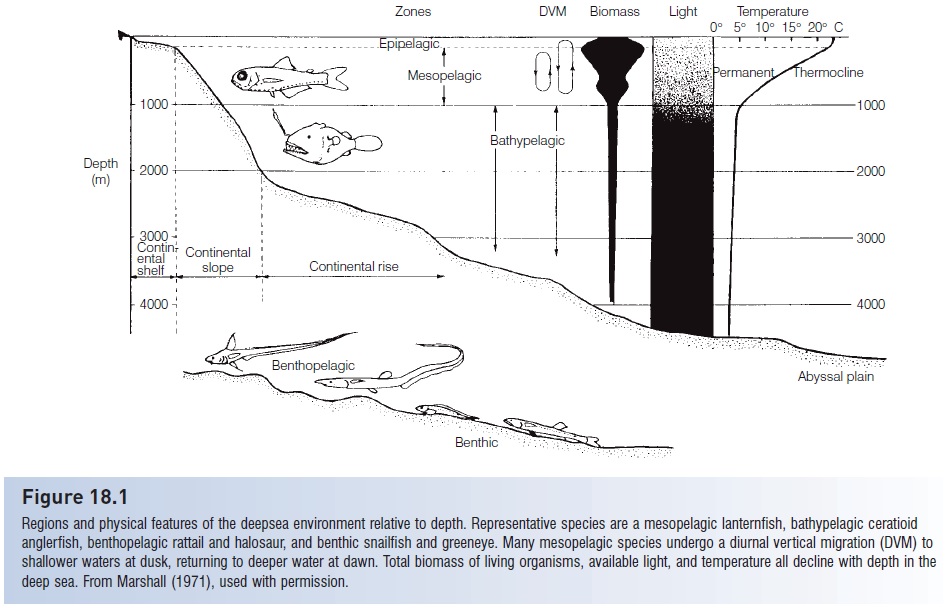Chapter: The Diversity of Fishes: Biology, Evolution, and Ecology: Special habitats and special adaptations
The deep sea
The deep sea
The most diverse deepsea fish assemblages occur between 40°N and 40°S latitudes, roughly between San Francisco and Melbourne, Australia in the Pacific Basin and between New York City and the Cape of Good Hope in the Atlantic Basin. Separation of deepsea fishes occurs more on a vertical than on a latitudinal basis (Fig. 18.1). The three major regions of open water are mesopelagic (200–1000 m), bathypelagic (1000–4000 m), and abyssal (4000–6000 m); deepsea regions below 6000 m are referred to as hadal depths. A second group of benthal or bottom-associated species swims just above the bottom (=benthopelagic) or lives in contact with it (=benthic), usually along the upper continental slope at depths of less than 1000 m; corresponding ecological zones of benthal species are referred to as bathyal, abyssal, and hadal. The upper 200 m of the open sea, termed the epipelagic or euphotic zone, has its own distinctive subset of fishes (see below). This is the region where the photosynthetic activity of phytoplankton exceeds the respiration of the plants and animals living there, i.e., where production/respiration >1. The euphotic zone is the energy source for the deeper waters (Marshall 1971; Wheeler 1975; Nelson 1994; Castro & Huber 1997, Neighbors & Wilson 2006).
The deepsea fishes of the mesopelagic and bathypelagic regions are readily recognized by just about anyone with a passing interest in fishes or marine biology. Deepsea fishes often have light-emitting organs, termed photophores;

Figure 18.1
Regions and physical features of the deepsea environment relative to depth. Representative species are a mesopelagic lanternfish, bathypelagic ceratioid anglerfish, benthopelagic rattail and halosaur, and benthic snailfish and greeneye. Many mesopelagic species undergo a diurnal vertical migration (DVM) to shallower waters at dusk, returning to deeper water at dawn. Total biomass of living organisms, available light, and temperature all decline with depth in the deep sea. From Marshall (1971), used with permission.
large or long mouths studded with daggerlike teeth; chin barbels or dorsal fin rays modified as lures; long, thin bones; and greatly enlarged, tubular eyes or greatly reduced eyes (Marshall 1954, 1971). Such familiar appearances could result from a relative scarcity of forms. For example, widespread familiarity with deepsea fishes could occur if we were exposed to many illustrations of the same strange animals. As the taxonomic listing in Table 18.1 reveals, the recognizability of deepsea fishes is not a function of scarcity or a depauperate fauna. More than 1000 species of fishes inhabit the open waters of the deep sea and another 1000 species are benthal, with good representation across orders of cartilaginous fishes and superorders of bony fishes. Similarities among unrelated fishes are therefore not due to phylogenetic relations but to convergent adaptations.
Deepsea fishes look alike because different ancestors invaded the deep sea from shallow regions and evolved similar anatomical and physiological solutions to an extreme environment. Understanding the convergent adaptations of deepsea fishes requires that we first understand the physical environment of the deep sea and its influences on biota. Five physical factors contrast markedly between the surface and the deep sea and appear to have been strong selective forces on fishes (Marshall 1971; Hochachka & Somero 1984).
Related Topics